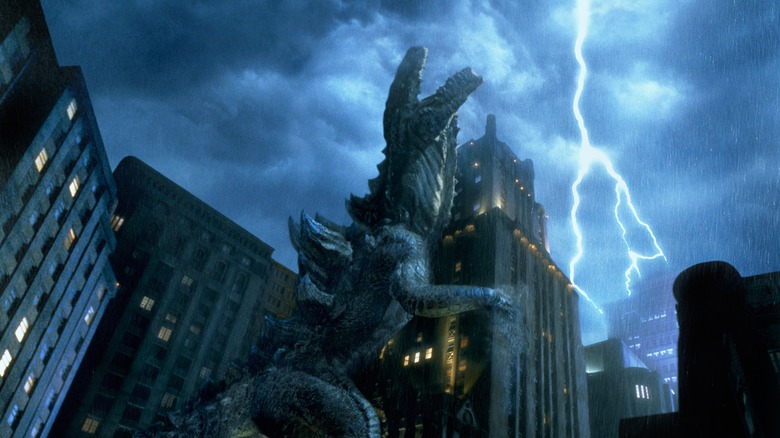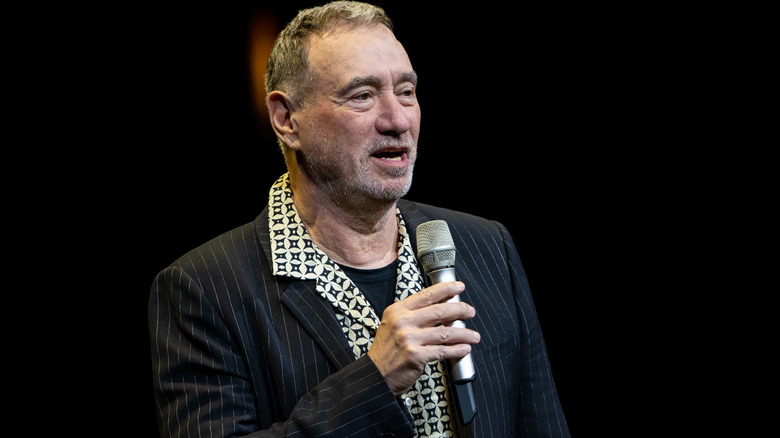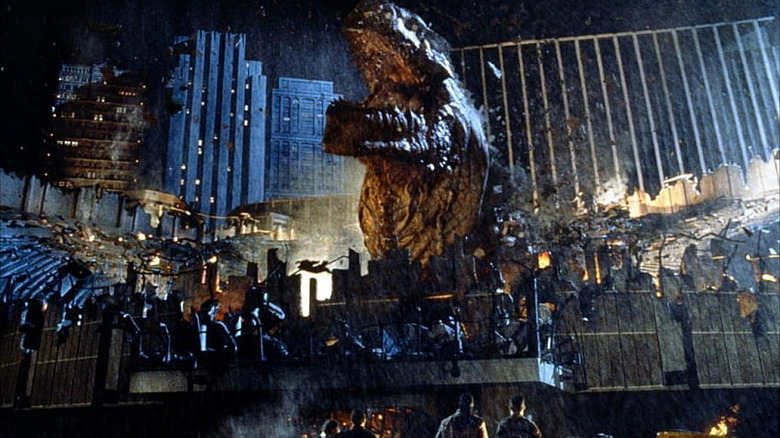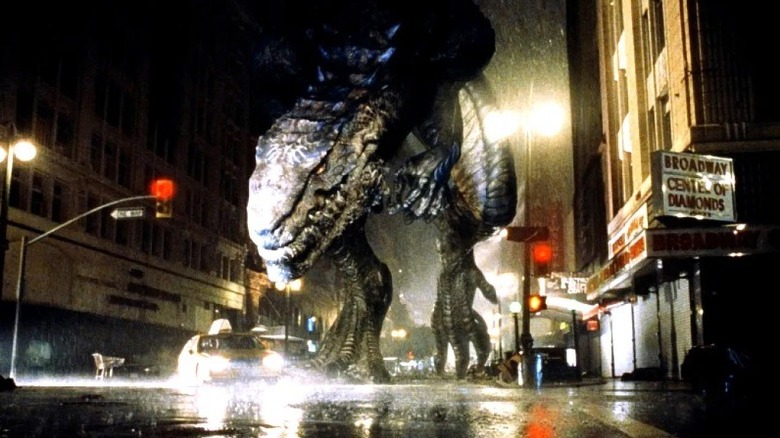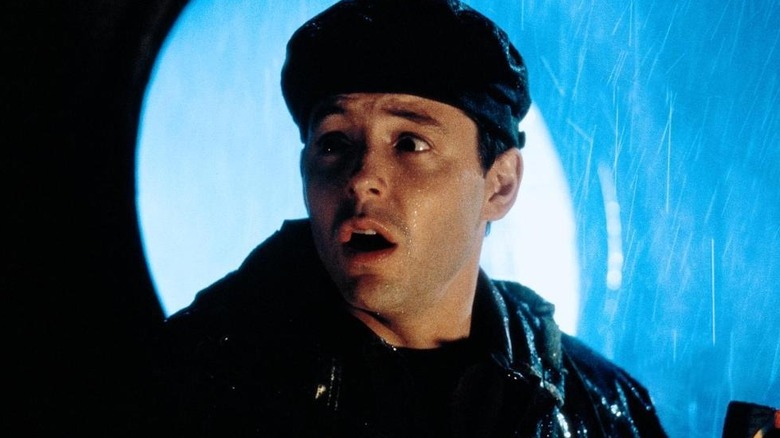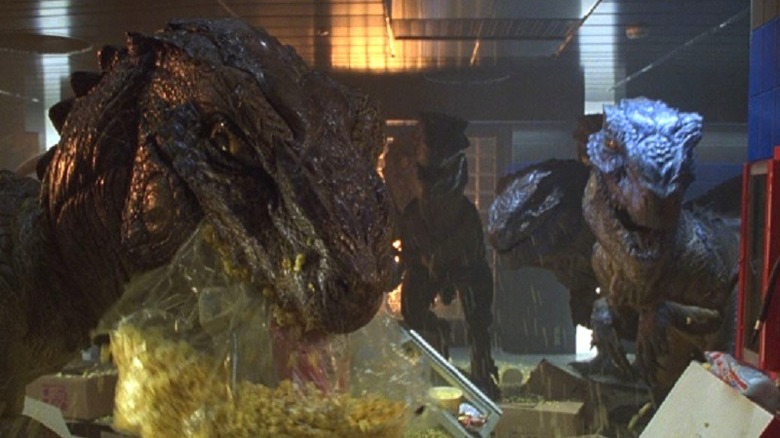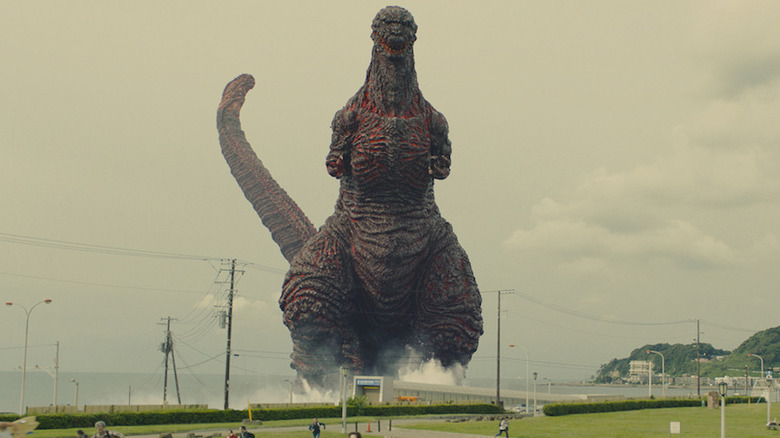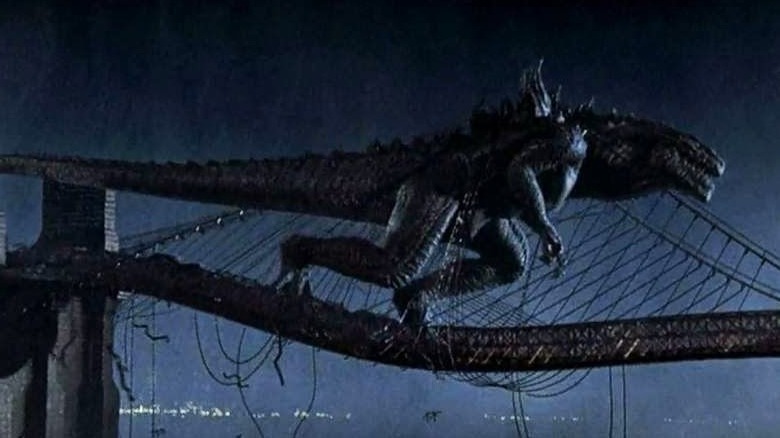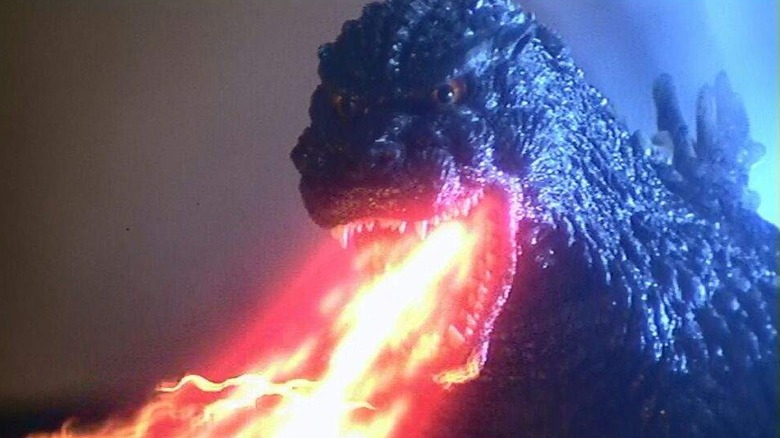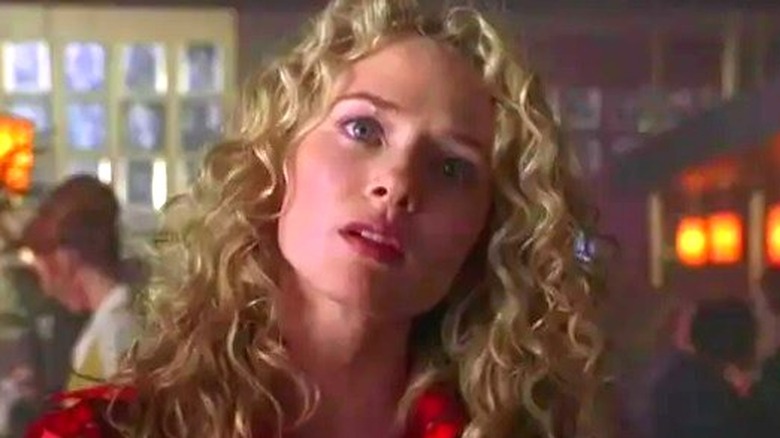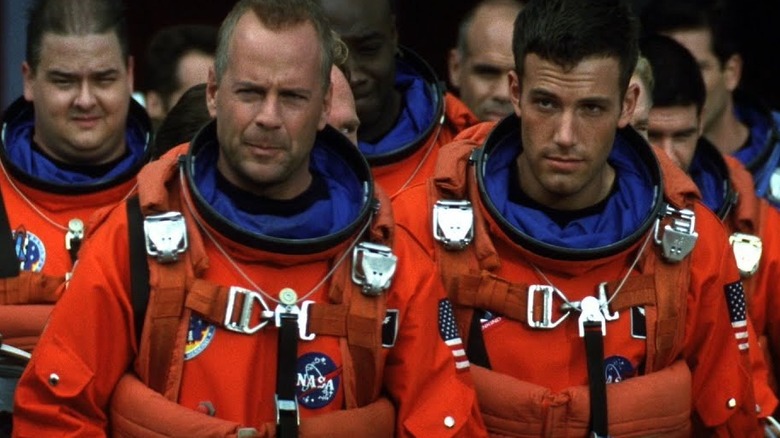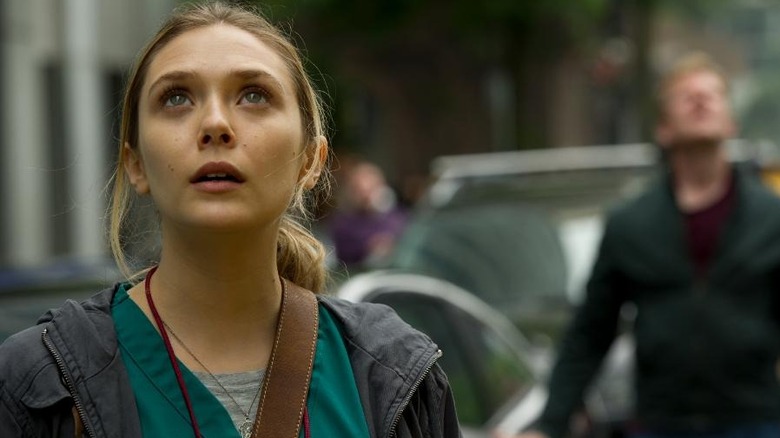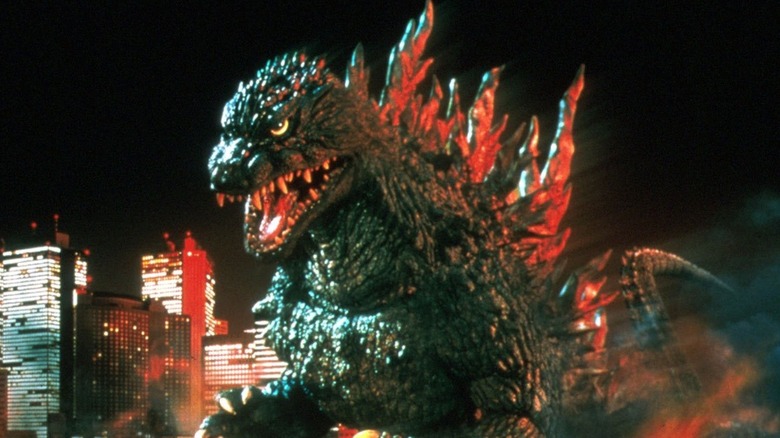Why The 1998 Godzilla Movie Bombed At The Box Office
Remarkably, the "Godzilla" movie franchise had already been around for 44 years and had 22 movies under its belt before the first American-made installment was released. Simply titled "Godzilla" and released in 1998 — we'll refer to it as "Godzilla '98" from here on out — Hollywood took a huge swing on this reboot of the beloved Japanese franchise. With a hefty reported production budget of $130 million, there were definitely high hopes that "Godzilla '98" would be the start of something big in the States.
Technically, "Godzilla '98" earned its production budget back, finishing with a worldwide tally of $379 million. But its domestic earnings were a mere $136 million, and it fell short of every single financial milestone that Sony — parent company of TriStar, which distributed the film — had expected of it. In addition, the aforementioned $130 million budget doesn't take into account the massive amount of cash spent to market the film.
By all the measures that mattered, "Godzilla '98" was a failure, and plans to turn it into a trilogy were immediately scrapped. To add further insult to injury, Toho — the Japanese production company that owns the franchise — began retroactively referring to both the movie and the titular creature as "Zilla" in its home territory in order to make it explicitly known that it should not be considered an official "Godzilla" movie, nor the creature a true Godzilla. Here's why "Godzilla '98" bombed at the box office.
Director Rolland Emmerich had no affection for Godzilla
An American-made "Godzilla" movie had been in the works for several years before the version that was ultimately released officially got underway, and several different directors were attached at various points. Jan de Bont of "Speed" and "Twister" fame circled the project for a bit, but the studio ultimately landed on Roland Emmerich to take the helm. Given that Emmerich's most recent film had been the hugely successful "Independence Day," it made him a smart choice from a financial perspective. But just because he knew how to make a disaster film didn't mean he was the right choice for a "Godzilla" movie.
In fact, to hear both Emmerich and producer and screenwriter Dean Devlin tell it, Emmerich had absolutely zero affection for the "Godzilla" franchise. Emmerich has been quoted as saying that he was never a fan of the Japanese movies, even saying that he and his friends would go see them in theaters just to laugh as kids. Directing an installment of a film franchise that you previously saw as a campy joke is clearly not going to bode well for the final product, and Emmerich's disdain for "Godzilla" became apparent in his insistence on changing pretty much everything that made the franchise and the character special.
It abandoned all of the symbolism and subtext of the original movies
In Roland Emmerich's defense, he certainly isn't the only person in the world who thinks that "Godzilla" movies are all just campy romps with no depth or complexity. But those who have actually watched the films, particularly the 1954 original, know that there's a lot more going on beneath the surface. The first movie actually deals with such heavy themes as the dangers of nuclear war and other social and political issues, all stemming from how Japan was affected by the aftermath of World War II.
Sure, subsequent "Godzilla" sequels only stuck with those metaphors to varying degrees, especially as the movies became a succession of battles between Godzilla and other giant monsters. But the Toho franchise always tended to return to those more serious and allegorical roots every few years, resetting itself after going a bit off the rails. "Godzilla '98" just went ahead and skipped that part altogether, going straight to being a generic disaster movie in an era when generic disaster movies were a dime a dozen. Stripping away everything that made the original "Godzilla" stand out from its peers all but guaranteed that "Godzilla '98" would fall short.
The creature basically just looks like a regular dinosaur
Godzilla's origin story in the 1954 movie is that he's a giant, prehistoric reptile that's reawakened due to radiation from hydrogen bomb testing. The exact nature of his species and the circumstances of his reemergence have shifted a bit over the decades, but he's generally been seen as an ancient, dinosaur-like creature. That being said, his design has always been very distinctive and unique, and even someone who's never watched a single second of any kaiju movies would be able to identify Godzilla on sight.
That makes the decision to turn him into a generic-looking dinosaur in "Godzilla '98" all the more baffling. It's one thing to slightly reinvent or modernize a classic creature. It's another thing entirely to render it not only completely unrecognizable, but to transform it into something that looks like it came out of a "Jurassic Park" rip-off. Even more disappointing is that the late, great Stan Winston had designed an excellent version of the creature for the early versions of "Godzilla '98." But by the time Roland Emmerich got on board, he scrapped it, claiming that a more classic Godzilla design didn't make sense for a modern film. The result was a creature that Godzilla fans have since taken to derisively referring to as G.I.N.O. — short for "Godzilla In Name Only."
Matthew Broderick was the wrong choice for the lead
Since Godzilla is a character with fairly limited cachet in the United States, you can't rely on the creature alone to sell your movie. That's why it's crucial to make sure that the human cast is full of names that'll get people to the theater. In 1998, Matthew Broderick was not such a name — certainly not with the oh-so-important 18-24 demographic that you need to impress for a movie like this to score big at the box office.
This was an era where the rising A-listers were the ones typically put at the front of movies like this — Will Smith, Ben Affleck, et al. Otherwise, the move was to go the opposite way and have a seasoned veteran take the lead, like "Deep Impact" did with Robert Duvall or "Armageddon" did with Bruce Willis. Broderick just kind of fell somewhere in the middle of those two extremes, and it didn't do "Godzilla '98" any favors in its marketability. The supporting cast wasn't much better — Jean Reno was still mostly just a star in France, Hank Azaria is typically associated with comedies and voicework, and Maria Pitillo is still really only known as the woman from "Godzilla '98."
The script was cobbled together from the work of multiple writers
The seeds for what eventually became "Godzilla '98" were first planted in 1992, when TriStar signed a deal with Toho to produce a trilogy of American-made "Godzilla" movies. The fact that the first (and only) installment of that trilogy didn't hit theaters until six years later is a pretty good indication that it wasn't exactly a smooth ride getting "Godzilla '98" made. We've already talked about how the project changed directors, but that's far from the only issue that the movie faced.
The first people hired to take a stab at the script were screenwriting duo Terry Rossio and Ted Elliot, who at that time were best known for their work on "Aladdin." After several drafts, another screenwriter named Don Macpherson was brought on to rewrite Rossio and Elliot's work. Then, when Roland Emmerich took over, he scrapped much of the existing work and started the screenplay almost completely from scratch with himself and Dean Devlin (though Rossio and Elliot maintained "story by" credits).
As is often the case when multiple writers or teams of writers take a crack at a script before it's passed to the next person or group, the story of "Godzilla '98" feels like it's being held together by duct tape, rather than something with a clear, concise creative vision from beginning to end.
Expensive, polished CG effects miss the point of Godzilla
Most countries don't spend what Hollywood spends on making movies. Looking at Japan in particular, the current record-holder for the most expensive Japanese film ever made is "The Tale of the Princess Kaguya" with a budget of only $40 million. In the United States, that would be considered a pretty modest cost for a major studio release. What that's meant for Japan's "Godzilla" movies over the years is a lot of practical effects and a lot of creativity to make it look like a giant monster is destroying a city without spending nine figures to accomplish that feat.
We're not here to rag on CGI — it can and has done some really amazing things, and there are countless modern classics that couldn't have been made without a heavy reliance on computers. But having to do a lot with less money and digital trickery has lent the Japanese "Godzilla" movies both a certain scrappy charm and a resistance to being turned into massive, hollow effects showpieces. That's never been the point of the franchise. Once you have the money and the resources to go big and shiny and bombastic, it's very hard not to go big and shiny and bombastic, which is what "Godzilla '98" did.
Production was rushed to meet a tight studio deadline
Filming a movie that has large-scale sets, dozens of actors, and a whole bunch of effects shots — both practical and digital — takes time. And the last thing you want to do is rush any aspect of such a production. But Hollywood is ultimately a business, and businesses need to make money. To that end, Sony determined that the way to maximize "Godzilla '98" at the box office was to have the movie come out over Memorial Day weekend, which is considered one of the best weekends to release a big tentpole film.
We've blamed Roland Emmerich multiple times in this feature for why "Godzilla '98" didn't pan out, but to be fair, he wasn't the only one making the decisions and pulling the strings on this massive production and its many moving parts. In fact, he puts part of the onus for why the movie wasn't all it could've been on the decision from the studio to give the film such a tight deadline, resulting in a rushed production. It's a valid complaint, and it's entirely possible that he could've executed better on his vision if he'd been given the proper amount of time to do so.
Fans balked at Godzilla's lack of fire breath
Taking Godzilla and making him into a fairly standard dinosaur wasn't just a visual change. The version in "Godzilla '98" is also robbed of most of the original creature's powers, which are replaced with greater speed and agility. The problem is that Godzilla's ability to breathe atomic fire is one of the most iconic aspects of the character — not to mention a direct metaphor for the destructive power of a nuclear blast, which gets at the heart of the allegorical nature of the original film.
When word got out that Zilla wasn't going to be able to breathe fire but instead just have a kind of air-based power breath, fans were irate. There was no Twitter to be outraged on back then, so they took to sending emails, writing letters, and even making phone calls to any point of contact they could find to get the message across. And it worked, as Emmerich and co-writer Dean Devlin were forced to add shots of the creature's breath being used to ignite other flame sources to give the general effect of it breathing fire.
Still, the damage had been done, and it started to become clear to the existing fans that "Godzilla '98" was making huge changes to the character's long-established rules. That did little to inspire confidence in the final product.
The film didn't have any test screenings
Test screenings can cause huge movie changes from what was originally intended. It's often debatable if the changes are for better or worse from a creative standpoint, but it's hard to argue that nobody knows what the audience wants more than the audience. For a big-budget movie like "Godzilla '98" that needs as many people to show up and enjoy it as possible, listening to audience feedback is pretty important.
Unfortunately, the studio decided that "Godzilla '98" would have no test screenings whatsoever — a combination of not wanting the public to see the final design of the creature before release and there simply not being enough time to make any changes the test audiences might have suggested. In fairness, there's really no way of knowing what kinds of changes test audiences might have recommended that could've saved the movie. But given that the film's earnings took a 59% nosedive in its second week, it's pretty clear that the feedback from the first-week audience had been heard loud and clear by everyone else.
Godzilla had tough competition from two other effects-driven disaster movies
A popular genre up through the 1970s, disaster films had fallen out of favor a bit in the '80s and early-'90s. But the success of "Twister" in 1996 helped revive the genre, and it was once again thriving in the years that followed. By 1998, disaster movies were so popular that three of them were released that summer alone — "Godzilla '98," "Deep Impact," and "Armageddon."
What had still been something of a novelty in the preceding years was now an increasingly crowded genre, and moviegoers were much less willing to automatically go see every movie that had trailers of impressive-looking destruction sequences. Having to compete with those other two movies definitely ate into "Godzilla '98" at the box office, with "Deep Impact" having been winding down its run at the time and ads for the upcoming "Armageddon" being ubiquitous in the weeks leading up to its release. So a lot of people probably saw "Deep Impact" and then decided to wait for "Armageddon" for their next disaster fix rather than rolling the dice on "Godzilla '98." It also didn't help that a little movie called "Saving Private Ryan" was also released that same summer, giving Zilla even more competition.
Godzilla movies often underperform at the U.S. box office
Godzilla is a household name in the U.S., and both the creature and its franchise surely have plenty of fans here. But the fact of the matter is that "Godzilla" movies in general haven't done particularly well historically at the U.S. box office — not even the American-made ones. "Godzilla '98" was the first, but it hasn't been the last. Thus far, there have been three more movies that either star or co-star the creature that were made outside of Japan, and not a single one of them has brought in a massive box office haul in the States.
2014 saw future "Rogue One" director Gareth Edwards take a crack at rebooting the franchise once again with the simply named "Godzilla." Starring MCU siblings Aaron Taylor-Johnson and Elizabeth Olsen, it did a seemingly respectable $200 million at the domestic box office, but that's a disappointing haul for a movie that cost $160 million to make. Its 2019 follow-up, "Godzilla: King of the Monsters," did far worse with only $110 million in the U.S. And the dual-sequel to both that movie and "Kong: Skull Island," 2021's "Godzilla vs. Kong," further continued the downward trend with a mere $101 million domestic.
Sure, the series has done well enough worldwide to justify its continued existence with another MonsterVerse movie, "Godzilla x Kong: The New Empire," on the way. But the fact remains that the U.S. box office wasn't much help, and Godzilla just might never be a big draw for most American moviegoers.
Toho quickly disowned the movie and announced its own reboot
Toho's "Godzilla" franchise is divided into eras, and it was between two of those eras — the Heisei era ('84 to '95) and the Millennium era ('99 to '04) — that "Godzilla '98" was released. With the franchise having been on hiatus at the time that TriStar approached Toho for permission to make American installments, Toho initially saw "Godzilla '98" as the first of a new official era for the franchise, even distributing the movie themselves in Japan.
However, Toho's enthusiasm for "Godzilla '98" all but disappeared once the movie was actually released. With abysmal reviews and an overall negative audience reception, the studio quickly walked back its original plan to embrace "Godzilla '98" as an official "Godzilla" movie or its creature as a true version of the character. But Toho didn't just stop at virtually disowning the movie.
By the time "Godzilla '98" hit Japanese theaters, Toho had already announced and begun production on its own revival of the franchise. This effectively hamstrung any chance "Godzilla '98" might have had at earning some money from Godzilla-starved fans in Japan, as they knew that they only needed to wait until the following year to get a real "Godzilla" movie in the form of 1999's Toho-produced "Godzilla 2000."
